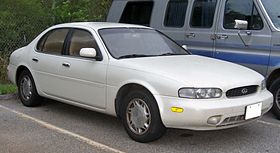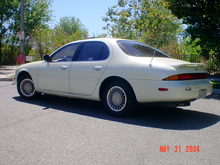Infiniti J30
This article relies largely or entirely on a single source. (November 2018) |
| Infiniti J30 (Y32) | |
|---|---|
 | |
| Overview | |
| Manufacturer | Infiniti |
| Also called | Nissan Leopard J Ferie |
| Production | 1992–1997 |
| Model years | 1993–1997 |
| Assembly | Tochigi, Tochigi, Japan |
| Designer | Doug Wilson (1989)[1] |
| Body and chassis | |
| Class | Mid-size luxury car |
| Body style | 4-door sedan |
| Layout | FR layout |
| Powertrain | |
| Engine | 3.0 L VG30DE V6 |
| Transmission | 4-speed automatic |
| Dimensions | |
| Wheelbase | 108.7 in (2,760 mm) |
| Length | 191.4 in (4,862 mm) |
| Width | 69.7 in (1,770 mm) |
| Height | 54.7 in (1,389 mm) |
| Curb weight | 3,580 lb (1,624 kg) |
| Chronology | |
| Predecessor | Infiniti M30 |
| Successor | Infiniti I30 |
The Infiniti J30, or Nissan Leopard J Ferie in Japan, was a rear wheel drive luxury car. The J30 went into production on April 7, 1992 as a 1993 model to replace the M30 (which was a coupe), and was launched in the United States after its competitor, the Lexus GS. The car was designed to slot between the smaller G20 and the larger Q45, as Infiniti's first mid-size sedan to compete directly with the Acura Legend. Also, it was fairly small but featured rounded styling uncharacteristic of the crowded executive car class, that is now reminiscent of a four-door coupé. Chief designer for the J30 was Jerry Hirshberg, president of Nissan Design International (NDI) and exterior designer Doug Wilson in 1988-1989. Design work was frozen in 1989. In a promotional video produced in 1994, it was referred to as a "personal luxury sedan" as attempt to define it as a four-door coupé. It has the round looks of the Nissan Altima/Bluebird U13.
To establish that this was a luxury vehicle, the interior was largely designed with assistance from Poltrona Frau [1] of Italy, whom they had previously worked with on the larger Q45. The interior treatment continued to use the contrasting arrangement from the larger Q45 with a dark color used for the dashboard, and center console, with a lighter shade color used inside for the seats, interior door panels, headliner, carpet, and carpeted floor mats. The driver's side window controls had an unusual placement in that the drivers window switch was both one-touch express down and double-sized, meaning it was the same width as two conventional window switches towards the top, with the front and rear passenger window switches further down, with the window lockout switch installed next to the front passenger switch, instead of the drivers window switch. The front passenger and rear passenger window switches were thumb activated, installed at the top of the interior door pull handle.
Unlike earlier Infinitis, the J30 received effective advertisement with jazz music and artistic camera shots. Power came from a 3.0 L VG30DE V6 (shared with the 300ZX) which produced 210 hp (157 kW) and 192 lb⋅ft (260 N⋅m) of torque. While it shares the Y32 Chassis with the Nissan Cedric/Gloria, it was essentially a rebadged version of the Japan-market Nissan Leopard, where it was offered with both the VG30DE and VH41DE V8.
All J30s were built in Tochigi, Tochigi, Japan. Production of the J30 ended on June 18, 1997, replaced by the Infiniti I30 (introduced in 1996). The J30 was packaged with a long list of standard features including (but not limited to) a leather interior, bronze tinted exterior glass, digital climate control, real burlwood trim surrounding the climate control unit, Bose sound system control module, and front ashtray, a power metal panel sunroof, dual 8-way power heated seats, dual airbags, variable speed sensitive power steering, and three-channel Anti-Lock brakes with ventilated discs front and rear.
One of the shortcomings of the J30 was its lack of interior room. It had the distinction of being a mid-size car with the space of a subcompact (less than a Sentra) due to its sloping roofline and shrunken trunk.
Infiniti also produced a touring model, the J30t. This model featured a rear spoiler, BBS style alloy wheels, a MacPherson strut front suspension with a multi-link suspension for the rear wheels (standard equipment on all J30 versions). For 1993 and 1994, Nissan offered a limited number of "gold package" J30t's. These cars had gold plated badging, upgraded interiors, upgraded heated front seats with embossed logos and HICAS, Nissan's four wheel steering technology. The J30 remained nearly unchanged through its production period. Heated seats became standard equipment in the 1994 model year. For 1995, the J30 received subtle vertical ribbing in the tail light lenses and in '96 the diagnostic system was upgraded to OBD2. Otherwise, the J30 received only minor alterations between 1993 and 1997 model years.
Advertisements[edit]
The J30 was launched with an ad campaign featuring Welsh actor Jonathan Pryce as the spokesman. Infiniti's chief competitors in the Japanese-American luxury car market, Acura and Lexus, used a similar technique in their commercials, which have also featured celebrity voice-overs, done by James Sloyan (Lexus) and James Spader (Acura).
References[edit]
External links[edit]
| show Infiniti, a division of Nissan Motor Co., Ltd., road car timeline, 1990–present
|
|---|
